ГЕРСАМИЯ А. Г.*, ГБУЗ «Научно-практический психоневрологический центр имени З. П. Соловьева Департамента здравоохранения г. Москвы», Москва, Россия, e-mail: aanna187@gmail.com
МЕНЬШИКОВА А. А.**, ГБУЗ «Научно-практический психоневрологический центр имени З. П. Соловьева Департамента здравоохранения г. Москвы», Москва, Россия, e-mail: menshikoff24@yandex.ru
ЯКОВЛЕВ А. А.***, Институт высшей нервной деятельности и нейрофизиологии РАН, Москва, Россия, e-mail: al_yakovlev@rambler.ru
В статье представлены данные об уровне стресса в детском возрасте и психологических особенностях личности у пациентов с аффективными расстройствами. Целью данного исследования было выявление связи детских травматических переживаний с развитием ряда личностных особенностей и копинг-стратегий, а также симптомов депрессии и тревоги во взрослом возрасте. В исследовании приняли участие 164 пациента психиатрического стационара. В результате авторы показали, что во взрослом возрасте высокий уровень перенесенного детского стресса связан с высоким уровнем депрессии и тревожности, повышением нейротизма и снижением согласия, а также использованием копинг-стратегий избегания и конфронтации.
Феномен стресса в детском возрасте рассматривается как важный этиологический фактор в развитии психических расстройств (Макарчук, 2004; Падун, Котельникова, 2012; Тарабрина, 2009; Точиева, 2008; Шитов, 2007; Allen, Lauterbach, 2007; Bendall et al., 2007; 2013; Lee, Tsenkova, Carr, 2014; Lenore, Terr, 1991; Mascher et al., 2012; Perroud et al, 2008; Somer et al., 2012; Sudbrack, Manfro, Kuhn, 2015). Ряд многочисленных исследований подтверждает взаимосвязь психической травмы и особенностей развития личности (Sachs- Ericsson et al., 2011; Stessman et al., 2008; Vielhauer, Findler, 2002; Acierno et al., 2007; Bright, Bowland, 2008; Haugebrook et al., 2010). В частности, существует определенная взаимосвязь между наличием стресса в детском возрасте и развитием избегающего (Yen et al., 2002), пограничного (Sansone et al., 2002; Weaver et al., 1993), антисоциального (Luntz et al., 1994) личностных расстройств, а также депрессивных, тревожных и фобических расстройств (Mendenhal, Jacobs, 2012; Kendler et al., 2004; Levitan et al., 1998; Schwarz, Perry, 1994). При этом переживание ситуации сильного стресса зависит от ряда объективных и субъективных характеристик переживания события и не всегда сопровождается психической травматизаци- ей. Есть исследования, согласно которым относительно средняя по тяжести детская травма может развить устойчивость к стрессу в будущем во взрослой жизни (Daskalakis et al., 2013; Nederhof, Schmidt, 2012). Уязвимость к негативным жизненным стрессовым событиям во многом обусловлена биологическими особенностями психики личности (Ellis et al., 2011). В частности, генетически заданный мозговой нейтрофический фактор оказывает влияние на пластичность и выживаемость дофаминергических, холинергических и серотонинергических нейронов мозга, с которыми связан риск развития аффективных расстройств (Angelucci, Brene, Mathe, 2005; Lee et al., 2014; Perea et al., 2012; Perroud et al., 2008; Perry et al., 1995). Стресс в детском возрасте как психическая травма негативно сказывается на развитии нейробиологических систем мозга и приводит к истощению его компенсаторных возможностей, что провоцирует манифестацию психических расстройств в будущем (Barr et al., 2003; Perea et al., 2012; Perroud et al., 2008).
В психологической литературе психической травмой принято считать, в первую очередь, внутреннее состояние человека, страдающего от расстройства, вызванного переживанием травматического события, а не сам факт травмы (Ван дер Харт, Нейенхэюс, Стил, 2013).
При этом детская травма определяется как результат физического или психологического покушения и/или наличия его угрозы в детском возрасте на физическую неприкосновенность, чувство самоуважения, а также жизнь самого ребенка или на физическую неприкосновенность или жизнь значимого для ребенка человека (Finding help for young children..., 2005, p. 171). К детской травматизации могут приводить следующие обстоятельства: насилие, включая сексуальное, физическое, эмоциональное; домашнее насилие; природные катастрофы (наводнение, пожар, землетрясение); боевые действия; заброшенность со стороны семьи; физическое насилие, связанное с угрозой для жизни, осуществляемое в присутствии ребенка (драки, стрельба и др.); физическое нападение на ребенка со стороны человека или животного или наличие его угрозы; похищение, издевательства; хирургические операции в результате несчастного случая или серьезного заболевания (Finding help for young children., 2005, p. 171).
Оценка события как психотравмирующего может быть сделана только на основании субъективного знания личности о том, какое воздействие на нее оказало переживание этого события. Исходя из этого, такая оценка возможна только спустя некоторое время после завершения события. Изучение психической травмы в детском возрасте занимает особое положение ввиду того, что травму переживает нуждающийся в особой заботе и поддержке ребенок с незрелыми психобиологическими структурами. Чем меньше возраст человека, пережившего травму, тем больше вероятность появления расстройства, вызванного травмой, ввиду неразвитых компенсаторных возможностей. При этом ребенок оценивает события детства зачастую необъективно, в зависимости не от их тяжести, а от той степени, в какой он был эмоционально в них вовлечен (Ван дер Харт, Нейенхэюс, Стил, 2013; Герсамия и др., 2015; Макарчук, 2004; Allen, Lauterbach, 2007; Angelucci, Brene, Mathe, 2005; Barr et al., 2003; Newberger, DeVos, 1988). Согласно данным исследователей, наиболее объективная оценка степени психической травматизации в детском возрасте возможна у взрослой личности (Шитов, 2007; Allen, Lauterbach, 2007; Angelucci, Brene, Mathe, 2005; Barr et al., 2003; Maschi et al., 2012). Исследования людей, переживших детский стресс, показывают, что у них отмечаются трудности в регулировке эмоций и произвольного поведения. Эти особенности влияют на повышение частоты межличностных конфликтов, импульсивных действий и самодеструктивно- го поведения (Simeon et al., 1992; Bornovalova et al., 2005; Gratz, 2006), гемблинга (Afifi et al., 2010), жестокости (McCrory, Viding, 2010), суицидального поведения (Lee, Tsenkova, Carr, 2014; Maschi et al., 2012; Perea et al., 2012; Risch, 2009; Somer et al., 2012).
Недостаточность исследований в отечественной литературе, посвященных ретроспективному исследованию степени травматизации личности, пострадавшей от насилия и жестокого обращения в детстве, а также ее взаимосвязи с рядом личностных особенностей, выраженности симптомов аффективных расстройств, обусловила потребность в проведении данной работы.
Целью нашего исследования было выявление связи личностных особенностей и используемых копинг-стратегий, а также симптомов депрессии и тревоги во взрослом возрасте у пациентов с аффективными расстройствами со стрессовыми воздействиями, перенесенными в детском возрасте.
В исследовании приняли участие 164 человека в возрасте от 18 до 58 лет (M=39,15; SD=17,367), среди них 128 женщин и 36 мужчин, проходивших лечение на базе НПЦ психоневрологии имени З.П. Соловьева ДЗМ по поводу расстройств тревожно-депрессивного спектра.
Использовались следующие методики: для определения уровня детского стресса - русскоязычный вариант Шкалы жестокого обращения и травматизации в детстве (CATS), разработанной в 1995 г. Б. Сандерсом и Е. Беккер-Лаусен и адаптированной в рамках настоящего исследования (А.Г. Герсамия и др., 2015); для оценки уровня депрессии - Шкала депрессии Бека (Beck, 1961, адаптация Н.В. Тарабриной (2001)); для оценки личностной и ситуационной тревоги - Опросник для оценки тревоги (Spielberger et al., 1983, адаптация Ю.Л. Ханина (1978)); для диагностики копинг-стратегий - Опросник «Стратегии совлада- ющего поведения» (Lazarus, Folkman, 1984; адаптация Т.В. Крюковой (2004)); для оценки базовых черт личности - Пятифакторный личностный опросник, NEO-FFI (Costa, McCrae, 1989, адаптация В.Е. Орла, А.А. Рукавишникова, И.Г. Сенина, Т.А. Мартина (2010)).
Для обработки полученных результатов и для оценки различий между двумя независимыми выборками использовался непараметрический статистический U-критерий Манна-Уитни. Статистическую обработку полученных результатов проводили при помощи пакета прикладных программ Statistica, версия 8.0.
Результаты и обсуждение
Все включенные в исследование лица были разделены на две группы: пациенты 1-й группы (N=81) имели высокий уровень детского стресса по Шкале CATS (M+SD) - выше 56 баллов; пациенты 2-й группа (N=83) - низкий уровень (M-SD) - ниже 22 баллов.
В результате сравнения групп пациентов с высоким и низким уровнем детского стресса были получены значимые различия между ними по целому ряду показателей.
Прежде всего, значимые различия между группами пациентов с высоким и низким уровнем детского стресса получены по показателям выраженности депрессивной и тревожной симптоматики (рис. 1).

Рис. 1. Сравнение показателей тяжести депрессии и тревоги в группах с высоким и низким уровнем детского стресса по шкале CATS (уровень достоверности различий: «*» - p<0,01; «**» - р<0,05; «***» - р<0,001)
Показатель выраженности депрессии по шкале Бека при поступлении у больных с низким уровнем детского стресса соответствовал уровню умеренно выраженного депрессивного расстройства (17,41±10,903), в то время как этот же показатель у больных с высоким уровнем детского стресса был значимо выше (p<0,01) и соответствовал выраженной депрессии (22,53±10,608). Показатели тяжести депрессивной симптоматики у больных без детского стресса оказались достоверно ниже (р<0,05) и при выписке (6,33±7,742), чем у больных со стрессом (8,71±8,126), хотя в обеих группах они были на уровне отсутствия симптоматики.
Значимые различия между группами обнаружены и по показателям ситуационной тревожности. При поступлении этот показатель в обеих группах больных соответствовал высокому уровню, однако у больных с детским стрессом выраженность тревоги (55,71±14,702) оказалась достоверно выше (р<0,05), чем у больных без детского стресса (50,79±15,206). Это соотношение сохранялось и при выписке пациентов, однако уровни тревоги в обеих группах опускались до умеренных и значимых различий между группами не обнаруживалось.
На основании полученных данных можно предположить, что стрессовые события в виде травматизации и жестокого обращения, перенесенные в детском возрасте, служат фактором, который утяжеляет течение расстройств тревожно-депрессивного спектра у взрослых.
В результате проведенного исследования была обнаружена взаимосвязь стресса, перенесенного в детстве, с особенностями личности человека во взрослом возрасте. Наше исследование показало, что существуют значимые различия между усредненными показателями в профилях базовых черт личности по Опроснику NEO-FF1 (рис. 2).
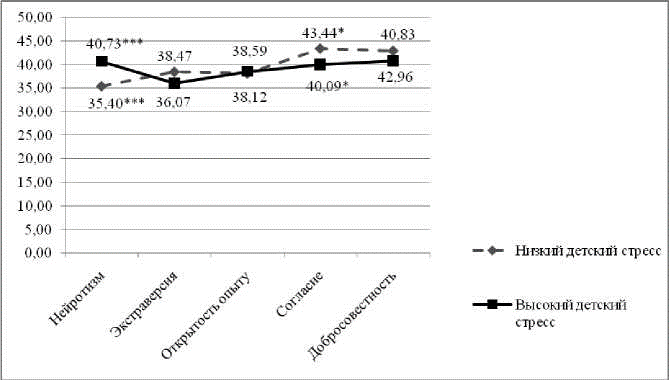
Рис. 2. Средние значения показателей базовых черт личности по Опроснику NEO-FF1 у обследованных с высокими и низкими уровнем детского стресса по шкале CATS (уровень достоверности различий: «*» - p<0,01; «**» - р<0,05; «***» - р<0,001)
Достоверные различия были обнаружены по двум основным факторам - фактору нейротизма (р<0,001) и фактору согласия (p<0,01). По фактору нейротизма и в той и в другой группе показатели соответствовали уровню очень высоких, однако в группе больных со стрессом (40,73±6,975) они оказались значимо выше, чем у больных без стресса (35,40±6,666). По фактору согласия результаты у группы больных с детским стрессом (40,09±7,490) оказались достоверно ниже (p<0,01), чем у больных с низким уровнем детского стресса (43,44±6,023), и соответствовали низким значениям, в то время как в группе с низким стрессам они соответствовали среднему уровню.
Таким образом, обследованные больные с диагностированным высоким уровнем детского стресса значимо более нестабильны эмоционально, более чувствительны к дистрессу и склонны к возникновению отрицательных эмоций, чем больные без детского стресса. Возможно, именно эти, чрезмерно заостренные, черты служат тем фактором, который приводит к более тяжелому течению у этих пациентов расстройств тревожно-депрессивного спектра. При этом им присущи черты, которые могут спровоцировать и ряд сложностей социально-психологического характера - низкая способность к согласию ведет к тому, что эти пациенты редко учитывают интересы и нормы группы, сообразуясь в большинстве случаев со своими принципами, и небрежны в отношениях с людьми.
Отличными в двух сравниваемых группах оказались и копинг-стратегии, или стили преодолевающего поведения (рис. 3).
Пациенты с высоким уровнем детского стресса достоверно чаще (р<0,001) используют стратегию избегания, причем если у больных с низким стрессом показатели по этой шкале соответствуют среднему уровню использования этой стратегии (10,60±4,508), то у больных с высоким стрессом уровень использования стратегии избегания поднимается до высокого и носит дезадаптивный характер (12,16±4,198). Стратегия бегства-избегания предполагает попытки преодоления личностью негативных переживаний за счет реагирования по типу уклонения: отрицания проблемы, пассивности, уклонения от ответственности и действий по разрешению возникших трудностей, фантазирования, неоправданных ожиданий, отвлечения и т. п. Использование этого механизма, развившегося в свое время в целях предотвращения или минимизации повторной травматизации и позволяющего быстро снизить эмоциональное напряжение, со временем приобретает у больных с высоким детским стрессом выраженно-гипертрофированный и генерализованный характер и выходит на первое место по частоте применения.

Рис. 3. Средние показатели используемых копинг-стратегий у обследованных с высоким и низким уровнем детского стресса по шкале CATS (уровень достоверности различий: «*» - р<0,01» «**» - р<0,05; «***»р<0,001)
На втором месте по частоте использования в группе больных с детским стрессом высокого уровня находится копинг-стратегия самоконтроля, которая используется ими в высокой степени (13,05±3,453) и достоверно (p<0,01) чаще, чем в группе с низким детским стрессом (использование на среднем уровне - 11,35±4,146). Стратегия самоконтроля предполагает попытки преодоления негативных переживаний за счет целенаправленного подавления и сдерживания эмоций, высокого контроля поведения, стремления скрывать от окружающих свои переживания, стремления к самообладанию.
С высокой достоверностью обе группы больных различаются по степени использования копинг стратегии принятия ответственности, которая в обеих группах, хоть и находится на среднем уровне использования, но все же достоверно выше (р<0,01) в группе больных, перенесших высокий уровень детского стресса (8,06±2,652), чем в группе больных с низким стрессом (6,73±2,819). Стратегия принятия ответственности предполагает признание субъектом своей роли в возникновении проблемы и ответственности за ее решение. При умеренном использовании данная стратегия отражает стремление личности к пониманию зависимости между собственными действиями и их последствиями, готовность анализировать свое поведение, искать причины актуальных трудностей в личных недостатках и ошибках.
Достоверно чаще (р<0,01) больные с высоким детским стрессом используют и такую стратегию, как «Поиск социальной поддержки». Несмотря на то, что показатели этой шкалы находятся на среднем уровне и в той и в другой группе, можно говорить о том, что больные с высоким уровнем детского стресса (12,10±3,466) в большей степени склонны к разрешению проблем за счет привлечения внешних (социальных) ресурсов, к поиску информационной, эмоциональной и действенной поддержки и более ориентированы на ожидание внимания, совета, сочувствия, чем больные с низким уровнем стресса (10,86±3,693).
С высокой достоверностью (p<0,01) группы обследованных различаются между собой также и по результатам использования конфронтационного копинг-механизма. Несмотря на то, что уровень использования этой стратегии и в той и в другой группах не выходит за рамки среднего, лица, перенесшие высокий детский стресс (9,10±2,994), достоверно чаще склонны к разрешению проблемы за счет осуществления конкретных действий, направленных либо на изменение ситуации, либо на отреагирование негативных эмоций в связи с возникшими трудностями, чем лица без стресса (7,01±2,631).
Значимо более высоким (р<0,05) в группе больных с высоким уровнем детского стресса оказались показатели актуальной стрессонаполненности жизни по Опроснику Холмса и Рея (352,50±197,380), в отличие от группы с низким стрессом (246,14±149,079). Несмотря на то, что эти показатели отражают не какие-либо личностные черты или субъективные особенности переживания стресса, а объективную наполненность жизни обследованных стресс-событиями, можно предположить, что сформировавшиеся под влиянием перенесенного в детстве стрессового воздействия особенности личности обследованных обусловливают недостаточную успешность, конструктивность организации ими свой жизни, семейных и социальных отношений, что в конечном итоге и провоцирует значительное количество неблагоприятных событий.
Для более детального анализа нами был предпринят сравнительный анализ групп больных с высоким и низким уровнем детского стресса в зависимости от ведущего психопатологического синдрома. Все обследованные были разделены на две группы - группу с ведущим депрессивным (N=51) и группу с ведущим тревожным психопатологическим синдромом (N=53). Внутри каждой из групп было проведено сравнение между больными с разным уровнем детского стресса.
В группе больных с ведущим депрессивным синдромом спектр показателей, по которым были получены значимые различия между лицами с высоким и низким детским стрессом, оказался достаточно небольшим (рис. 4).
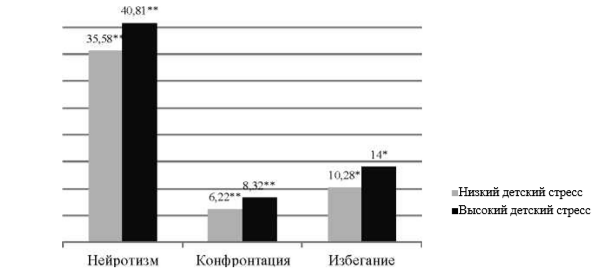
Рис. 4. Средние значения показателей личностных черт и используемых копинг-стратегий
в группах с высоким и низким уровнем детского стресса по шкале CATS у больных с ведущим де-
прессивным синдромом (уровень достоверности различий: «*» - p<0,01; «**» -р<0,05; «***» - р<0,001)
Значимые различия между группами с высоким и низким уровнем детского стресса среди больных с ведущим депрессивным синдромом были получены по показателям такой базовой черты личности, как нейротизм, значения которого в обеих группах находились на уровне очень высоких (низкий стресс - 35,58±5,347, высокий стресс - 40,81±6,775), но при выраженном детском стрессе были значимо выше (р<0,05). Достоверно отличались также и результаты по используемым механизмам совладания - по конфронтационному (низкий стресс - 6,22±2,922, высокий стресс - 8,32±2,880, р<0,05) и избегающему (низкий стресс - 10,28±3,982, высокий стресс - 14,00±3,873, p<0,01) копингам, которые, тем не менее, и в той и в другой группах соответствовали средним значениям.
Как и в случае с общей выборкой, в группе больных с высоким показателем детского стресса значимо (р<0,05) выше оказался и уровень актуальной стрессонаполненности жизни (низкий стресс - 305,67±179,123, высокий стресс - 432,22±197,677).
Более массированными оказались различия между группами с высокими и низкими показателями детского стресса среди больных с ведущим тревожным синдромом. В первую очередь, эти различия касались степени выраженности депрессивной симптоматики (рис. 5).
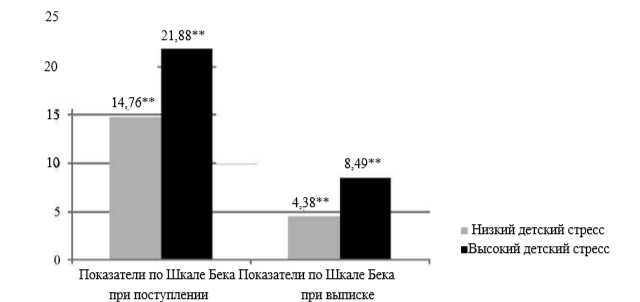
Рис. 5. Сравнение показателей тяжести депрессии и тревоги в группах с высоким и низким уровнем детского стресса по шкале CATS у больных с ведущим тревожным синдромом (уровень достоверности различий; «*» - p<0,01; «**» - р<0,05; «***» -р<0,001)
Как и в общей группе, для больных с тревожным синдромом с высоким детским стрессом достоверно выше (р<0,05) оказались показатели уровня выраженности депрессии по Шкале Бека при поступлении (21,88±11,230), соответствуя уровню выраженной депрессии (умеренная в группе с низким стрессом - 14,76±12,095). С такой же достоверностью (р<0,05) у этих больных оказались выше показатели по этой шкале и при выписке (низкий стресс - 4,38±7,665, высокий стресс - 8,49±9,840), хотя формально и соответствовали уровню отсутствия депрессивной симптоматики.
Более широкими оказались изменения, связанные с перенесенным детским стрессом у больных с тревожным синдромом и на личностном уровне (рис. 6).
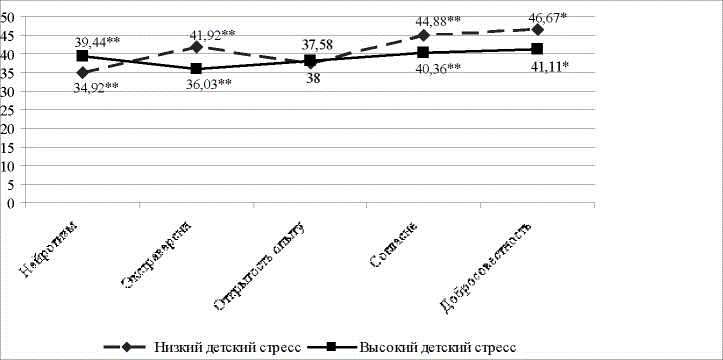
Рис. 6. Средние значения показателей базовых черт личности по Опроснику NEO-FF1 у обследованных с высокими и низкими уровнем детского стресса по шкале CATS у больных с ведущим тревожным синдромом (уровень достоверности различий: «*»p<0,01; «**» - р<0,05; «***» - р<0,001)
Как и в группе с ведущим депрессивным синдромом, у больных с высоким уровнем стресса оказались достоверно выше (р<0,05) показатели по фактору нейротизма (низкий стресс - 34,92±6,807, высокий стресс - 39,44±7,245). Помимо этого, достоверно более низкими (р<0,05) при высоком уровне детского стресса оказались различия по фактору экстраверсии (низкий стресс - 41,92±7,306, высокий стресс - 36,03±6,808), согласия (низкий стресс - 44,88±5,705, высокий стресс - 40,36±7,241) и добросовестности (низкий стресс - 46,67±6,295, высокий стресс - 41,11±6,594, p<0,01). Таким образом, больные с ведущим тревожным синдромом и высоким уровнем стресса, перенесенного в детстве, не только более нестабильны эмоционально, уязвимы к негативным воздействиям и склонны к негативным переживаниям, чем больные с низким уровнем стресса, но и менее мотивированны и организованы в целенаправленном поведении, слабее контролируют собственные импульсы, склонны к экспериментам. При этом они больше склонны к независимости, самостоятельности, менее контактны, испытывают затруднения в учете интересов группы, эгоцентричны.
Более развернутыми в группе больных с тревожным синдромом оказались и изменения, касающиеся свойственных им механизмов преодоления стрессовых ситуаций или копинг-механизмов (рис. 7).
Больные с высоким стрессом значимо чаще используют не только конфронтационный копинг (низкий стресс - 6,71±2,331, высокий стресс - 9,72±2,698, р<0,001), но и избегание (низкий стресс - 8,67±4,669, высокий стресс - 14,10±3,569, р<0,001), самоконтроль (низкий стресс - 10,71±4,573, высокий стресс - 13,52±3,481, р<0,05), поиск социальной поддержки (низкий стресс - 10,75±3,124, высокий стресс - 13,31±2,537, p<0,01) и принятие ответственности (низкий стресс - 5,75±2,212, высокий стресс - 8,10±2,717, p<0,01). Причем если у больных с низким детским стрессом использование этих копинг механизмов соответствует или низкому или среднему адаптивному уровню, то при высоком стрессе стратегии самоконтроля, поиска социальной поддержки, бегства и избегания начинают эксплуатироваться с высокой интенсивностью, напряженностью и становятся дезадаптивными для личности.
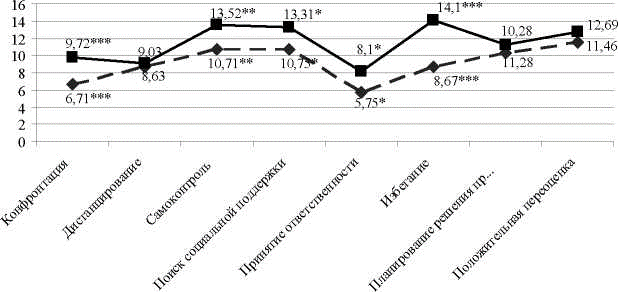
—Низ Низкий детский стресс —■------- Высокий детский стресс
Рис. 7. Средние показатели используемых копинг-стратегий у обследованных с высоким и низким уровнем детского стресса по шкале CATS у больных с ведущим тревожным синдромом (уровень достоверности различий: «*» - p<0,01; «**» - р<0,05; «***» р<0,001)
Заключение
Полученные результаты свидетельствуют о том, что при аффективных расстройствах во взрослом возрасте высокий уровень детского стресса связан с увеличением показателей выраженности депрессивной симптоматики и более высокой реактивностью по отношению к различным неблагоприятным стимулам в виде переживания состояния интенсивной тревоги.
Высокая нагруженность негативным аффектом и стресс-реактивность тесно связаны с такой чертой личности, как высокий уровень нейротизма. Эмоциональная нестабильность, беспокойство и нервозность, легкость возникновения отрицательных эмоций оказались присущи всем пациентам с расстройствами тревожно-депрессивного спектра, однако в случае высоких показателей пережитого детского стресса эти черты значительно заостряются и становятся более выраженными. Детский травматический опыт связан с качеством отношений человека с другими людьми, что выражается в низком уровне такой черты, как согласие, связанной с эгоцентризмом и равнодушием к интересам окружающих.
В зависимости от уровня детского стресса различаются и предпочтения используемых способов взаимодействия личности с проблемной (стрессовой) или кризисной ситуацией, стили преодолевающего поведения личности. Общая конфигурация усредненных профилей копинг-стратегий у пациентов с тревожно-депрессивными расстройствами при высоком и низком уровне детского стресса схожа между собой. Однако полученные результаты свидетельствуют о том, что больные с высоким уровнем стресса в детском возрасте значимо более интенсивно используют стратегии избегания и самоконтроля, а также поиск социальной поддержки, конфронтацию и принятие ответственности.
Уровень актуальной стрессонаполненности жизни также оказался более высоким у пациентов с тревожно-депрессивными расстройствами при интенсивном детском стрессе. Можно предположить, что специфические особенности личности и поведения, сформировавшиеся под влиянием пережитого стресса в детском возрасте, провоцируют формирование особого, более травматичного и наполненного неблагоприятными ситуациями, образа и стиля жизни.
Исследование показало, что характер аффективных и личностных изменений, а также особенности использования копинг-стратегий, связанных с пережитым в детстве стрессом, у больных с тревожно-депрессивными расстройствами в значительной мере зависят от ведущего психопатологического синдрома. По сравнению с пациентами с низким уровнем детского стресса, в случае ведущего тревожного синдрома при высоком уровне перенесенного детского стресса более выражен нейротизм, снижены экстраверсия, согласие и добросовестность. Ведущими копинг-стратегиями являются самоконтроль, избегание и более интенсивно, чем при низком уровне детского стресса, использовались конфронтация и поиск социальной поддержки. В случае ведущего депрессивного синдрома пациенты с высоким уровнем детского стресса отличались высоким уровнем нейротизма, более интенсивным использованием копинг-стратегий конфронтации и избегания, а также и более высокими показателями актуальной стрессонаполненности жизни.
Таким образом, проведенное исследование показало, что перенесенный в детском возрасте стресс в виде жесткого обращения и насилия находит свое отражение в психологических особенностях взрослой личности у пациентов с расстройствами тревожнодепрессивного спектра.
1 Герсамия А. Г. Психолог, ГБУЗ «Научно-практический психоневрологический центр имени З.П. Соловьева Департамента здравоохранения г. Москвы». E-mail: aanna187@gmail.com
2 * Меньшикова А. А. Старший научный сотрудник, ГБУЗ «Научно-практический психоневрологический центр имени З.П. Соловьева Департамента здравоохранения г. Москвы». E-mail: menshikoff24@ yandex.ru
3 ** Яковлев А. А. Старший научный сотрудник, Институт высшей нервной деятельности и нейрофизиологии РАН. E-mail: al_yakovlev@rambler.ru